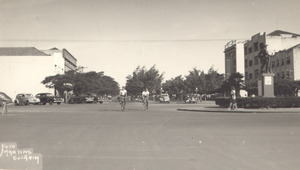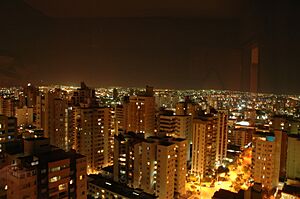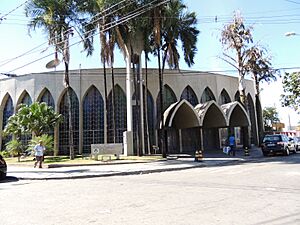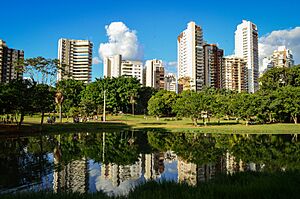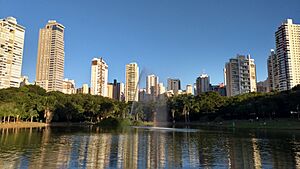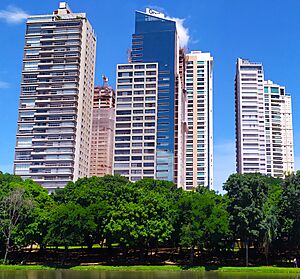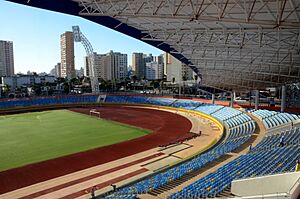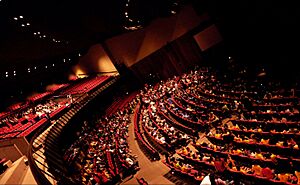Goiânia facts for kids
Quick facts for kids
Goiânia
|
|||
|---|---|---|---|
|
Municipality
|
|||
| Municipality of Goiânia | |||
|
Skyline of Goiânia
Monument to the Three Races
Train Station
Viaduct Latif Sebba
Viaduct João Alves de Queiroz
Vaca Brava Park
Oscar Niemeyer Cultural Center
|
|||
|
|||
| Nickname(s):
Capital do Cerrado (Capital of the Cerrado)
|
|||

Location of Goiânia
|
|||
| Country | |||
| Region | Central-West | ||
| State | |||
| Founded | October 24, 1933 | ||
| Area | |||
| • Municipality | 789 km2 (305 sq mi) | ||
| • Metro | 739 km2 (285 sq mi) | ||
| Elevation | 749 m (2,457 ft) | ||
| Population
(2022)
|
|||
| • Municipality | 1,437,366 (10th) | ||
| • Density | 1,604/km2 (4,150/sq mi) | ||
| • Metro | 2,890,418 (12th) | ||
| Demonym(s) | goianiense | ||
| GDP (PPP, constant 2015 values) | |||
| • Year | 2023 | ||
| • Total | $32.9 billion | ||
| Time zone | UTC-3:30 (UTC-3:30) | ||
| Postal code |
74000-000
|
||
| Area code | +55 62 | ||
| HDI (2010) | 0.799 – high | ||
Goiânia is a large and important city in Brazil. It is the capital city of the state of Goiás. About 1.5 million people live here, making it one of the biggest cities in Brazil. If you include the areas around it, the population grows to almost 2.9 million people.
The city was carefully planned before it was built. It was founded on October 24, 1933. The goal was to create a new capital for the state of Goiás. Before Goiânia, the capital was a town called Goiás.
Goiânia is a key center for business in its region. It's important for industries, medicine, fashion, and farming. The city is also known for its many green spaces. Some people say it has one of the largest green areas per person in Brazil.
History of Goiânia
The idea of building a new state capital in Goiás started a long time ago. People wanted to move the capital to a better location. The first capital, Vila Boa (now called City of Goiás), was chosen when gold mining was important. Later, when farming and raising cattle became the main activities, the old capital felt too far away.
Lawmakers kept the idea of moving the capital alive for many years. In 1891, they even put it in the state's constitution. This idea became a real plan in 1930. This was when Pedro Ludovico became the new governor of Goiás.
Choosing the New Capital's Location
In 1932, a group was formed to pick the best spot for the new capital. They chose the area of Campinas. The mayor of Campinas, Andrelino Rodrigues de Moraes, agreed to the plan. He gave about 242 acres of his land for the city. In 1933, the current location was chosen. The first stone was laid to mark the start of construction.
The city was planned for 50,000 people. It was designed with streets spreading out from a central point. This center was the Praça Cívica, where the government buildings would be. These included the Palace of Emeralds and the Palace of Campinas.
In 1937, a special order was signed. It officially moved the state capital from Cidade de Goiás to Goiânia. The city was officially opened in 1942. The president of Brazil and other important leaders were there.
How Goiânia Got Its Name
The name "Goiânia" was chosen in 1933. A local newspaper held a contest for readers to suggest names. Many names were sent in, like Petrônia, Americana, and Goianópolis. In 1935, Governor Pedro Ludovico used the name Goiânia for the first time. He signed a document creating the municipality with this name.
Art Deco Architecture
The first buildings in Goiânia were designed by Attilio Correia Lima. They were built in the art deco style. This style was popular in the 1920s and 1930s. It uses geometric shapes and bold lines.
Many of these early buildings are still standing. Twenty-two of them are now protected as national heritage sites. They were mostly built in the 1940s and 1950s. These buildings are in the old center of Goiânia and in the Campinas area.
Understanding the 1987 Incident
On September 13, 1987, a medical device was taken from an old hospital. This device contained a small amount of a special material. This material could glow with a soft blue light when exposed to air. People who saw the glow were curious. Some even took small pieces of the material.
This led to some people getting sick. City and state officials acted quickly to help everyone. They worked to clean up the affected areas. This event showed how important it is to handle special materials safely.
Geography and Climate
Goiânia has a tropical wet and dry climate. This means it has two main seasons. One is a wet season, from October to April. The other is a dry season, from May to September. The average temperature is around 23.2 degrees Celsius (73.8 degrees Fahrenheit).
Weather Patterns
The city gets about 1300 millimeters (51 inches) of rain each year. The lowest temperature ever recorded was 0.5 degrees Celsius (32.9 degrees Fahrenheit) in July 2000. But very cold temperatures like this are rare. The highest temperature recorded was 41.2 degrees Celsius (106.2 degrees Fahrenheit) in October 2020.
| Climate data for Goiânia (1991–2020) | |||||||||||||
|---|---|---|---|---|---|---|---|---|---|---|---|---|---|
| Month | Jan | Feb | Mar | Apr | May | Jun | Jul | Aug | Sep | Oct | Nov | Dec | Year |
| Record high °C (°F) | 35.2 (95.4) |
34.6 (94.3) |
34.4 (93.9) |
34.0 (93.2) |
33.7 (92.7) |
32.6 (90.7) |
33.3 (91.9) |
36.2 (97.2) |
39.9 (103.8) |
41.2 (106.2) |
36.2 (97.2) |
35.4 (95.7) |
41.2 (106.2) |
| Mean daily maximum °C (°F) | 30.6 (87.1) |
31.0 (87.8) |
30.9 (87.6) |
31.2 (88.2) |
30.3 (86.5) |
30.0 (86.0) |
30.6 (87.1) |
32.7 (90.9) |
34.0 (93.2) |
33.2 (91.8) |
31.1 (88.0) |
30.6 (87.1) |
31.4 (88.4) |
| Daily mean °C (°F) | 24.7 (76.5) |
24.7 (76.5) |
24.7 (76.5) |
24.8 (76.6) |
23.3 (73.9) |
22.3 (72.1) |
22.5 (72.5) |
24.5 (76.1) |
26.3 (79.3) |
26.2 (79.2) |
25.0 (77.0) |
24.8 (76.6) |
24.5 (76.1) |
| Mean daily minimum °C (°F) | 20.1 (68.2) |
20.0 (68.0) |
20.0 (68.0) |
19.3 (66.7) |
16.9 (62.4) |
15.2 (59.4) |
14.8 (58.6) |
16.6 (61.9) |
19.4 (66.9) |
20.3 (68.5) |
20.3 (68.5) |
20.2 (68.4) |
18.6 (65.5) |
| Record low °C (°F) | 9.1 (48.4) |
15.4 (59.7) |
14.0 (57.2) |
11.2 (52.2) |
5.7 (42.3) |
3.5 (38.3) |
0.5 (32.9) |
6.8 (44.2) |
10.4 (50.7) |
13.7 (56.7) |
14.4 (57.9) |
12.9 (55.2) |
0.5 (32.9) |
| Average precipitation mm (inches) | 249.2 (9.81) |
235.8 (9.28) |
258.5 (10.18) |
137.7 (5.42) |
30.3 (1.19) |
8.4 (0.33) |
1.5 (0.06) |
9.5 (0.37) |
44.3 (1.74) |
144.1 (5.67) |
219.6 (8.65) |
271.9 (10.70) |
1,610.8 (63.4) |
| Average precipitation days (≥ 1.0 mm) | 17 | 16 | 17 | 9 | 3 | 1 | 0 | 1 | 4 | 11 | 16 | 18 | 113 |
| Average relative humidity (%) | 72.2 | 72.2 | 72.4 | 66.2 | 59.9 | 55.1 | 48.0 | 40.8 | 44.9 | 57.2 | 69.3 | 72.6 | 60.9 |
| Average dew point °C (°F) | 19.8 (67.6) |
19.8 (67.6) |
19.9 (67.8) |
18.8 (65.8) |
16.2 (61.2) |
14.2 (57.6) |
12.4 (54.3) |
11.7 (53.1) |
13.9 (57.0) |
17.3 (63.1) |
19.3 (66.7) |
19.8 (67.6) |
16.9 (62.5) |
| Mean monthly sunshine hours | 182.9 | 158.2 | 204.6 | 228.0 | 251.1 | 270.0 | 288.3 | 282.1 | 213.0 | 189.1 | 174.0 | 173.6 | 2,614.9 |
| Mean daily sunshine hours | 5.9 | 5.6 | 6.6 | 7.6 | 8.1 | 9.0 | 9.3 | 9.1 | 7.1 | 6.1 | 5.8 | 5.6 | 7.2 |
| Mean daily daylight hours | 13 | 12.6 | 12.2 | 11.7 | 11.3 | 11.1 | 11.3 | 11.6 | 12.0 | 12.5 | 12.9 | 13.1 | 12.1 |
| Average ultraviolet index | 16 | 16 | 14 | 13 | 10 | 8 | 9 | 11 | 12 | 15 | 16 | 16 | 13 |
| Source 1: Instituto Nacional de Meteorologia | |||||||||||||
| Source 2: Weather atlas(sun-Daylight) Nomadseason(UV) | |||||||||||||
Local Plants and Animals
The area around Goiânia is called the "cerrado". This is a type of savanna with many different plants. You can find forests along rivers and streams. There are also open fields and areas with special palm trees.
The cerrado is home to many animals. Over 1600 types of mammals, birds, and reptiles live here. This includes 180 types of reptiles and 837 types of birds. Termites and leaf-cutter ants are very important. They help break down dead plants and are food for other animals.
Economy and Jobs
Goiânia's economy today has many different parts. But it started with farming. The city still sells a lot of farm equipment and products. This makes up a big part of its business.
Main Industries in Goiânia
After farming, selling and fixing vehicles is a major industry. You can see many car repair shops and dealerships around the city.
The government also provides many jobs. Since Goiânia is the state capital, many government offices are located here.
In recent years, modern communication technology has grown. Many large Brazilian companies have opened offices in Goiânia. The city also has many private medical centers and clinics.
In 2005, the city's total economic output was about R$13.35 billion. The average income per person was about R$11,119.
People and Culture

In 2011, Goiânia had over 1.3 million people. It is the most populated city in the state of Goiás. It is also the 12th largest city in Brazil. The area around Goiânia and Brasília has grown a lot. This makes it one of the biggest city areas in Brazil.
Understanding Social Equality
Goiânia has fewer "favela" areas compared to other big cities in Brazil. Favelas are informal housing areas. In Goiânia, most homes in these areas still have electricity, water, and trash collection.
While not fitting the "favela" description, some areas on the city's edges have lower incomes.
Diverse Backgrounds of Residents
Goiânia is a city with people from many different backgrounds. This is because many people have moved here over the years. Most migrants come from other parts of Goiás and other Brazilian states.
Many people have moved from states like Minas Gerais and Bahia. The city's founding helped the state's population grow. This is because the old capital was shrinking. Goiânia's growth is seen as a success story for Brazil's interior.
Religious Beliefs in Goiânia
Goiânia has many different religious groups. Most people are Catholic (50.8%). A large number are also evangelical (32.4%). About 4.2% follow Spiritism. Around 10% of the people do not have a religion. Other religions are also present in the city.

Education in Goiânia
Goiânia has several important universities and institutes:
- Universidade Federal de Goiás (UFG)
- Pontifícia Universidade Católica de Goiás (PUC-GO)
- Universidade Estadual de Goiás (UEG)
- Instituto Federal de Educação, Ciência e Tecnologia de Goiás (IFG)
- Faculdade Unida de Campinas (FacUnicamps)
City Services and Transport
Roads and Driving
Goiânia is connected to other major cities by good roads. A four-lane highway (BR-060) links it to Brasília. Another four-lane highway (BR-153) connects it to São Paulo. The state of Goiás also maintains main roads (GO-xxx) in and out of the city.
The central parts of Goiânia were planned, making them easy to get around. However, as the city grew quickly, this planning wasn't always followed. This has led to traffic problems. Goiânia has a very high number of cars per person in Brazil. This causes big traffic jams during busy times.
Public Transportation
All public transport in Goiânia is by bus. Several companies run the bus service under the city's management.
There is a bus system map available online. Buses usually run on a set schedule. Goiânia uses a special technology for its bus system. Passengers use magnetic cards to pay, not cash. These cards can be bought from vendors or small shops.
Anhanguera Avenue is a very long street in the city. It has a special bus lane in the middle. This lane has bus stations every half kilometer. Buses on this route are often articulated buses, which are longer. The fare for this route is half the normal price.
Future Bus System Changes
New plans are being made to improve the bus system.
- Bus stations are being updated.
- Buses will have GPS to help with schedules. They will also be more accessible for people with disabilities.
- A new service called CityBus will offer smaller buses. This is for people who want a different public transport option.
- There are plans for a new North-South bus route.
- A control center will monitor bus traffic using GPS.
- A phone number will let users know when the next bus will arrive.
Airports Serving Goiânia
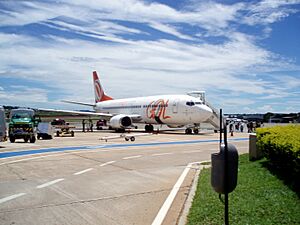
Santa Genoveva Airport is located on the northeast side of Goiânia. Several airlines fly from here to other cities in Brazil. A new, larger Santa Genoveva International Airport opened in May 2016. It can handle up to 6.5 million passengers each year.
The Aeródromo Nacional de Aviação handles smaller, private plane flights.
City Safety and Security
Goiânia is generally considered a safe city compared to many other state capitals in Brazil. The Goiás Military Police patrols the city. They respond to crimes and maintain checkpoints. The Civil Police handles crime investigations and other administrative tasks.
Traffic rules are enforced by the "AMT" (Municipal Traffic Agency). These traffic wardens help keep roads safe and respond to accidents.
Green Spaces and Parks
Goiânia has many tall buildings in its center. But it also has many single-story homes surrounded by trees. Many streets have tropical fruit trees. The city has many parks with parts of the original forest. About 30% of the city's area is covered in trees.
Popular Parks in Goiânia
Some of the most important parks are:
- Parque Zoológico (Zoo Park)
- Parque Vaca Brava
- Parque Ecológico
- Bosque dos Buritis
- Parque Areião
One of the biggest parks is the Bosque dos Buritís. It has an area of 140,000 square meters. It is home to many buriti palm trees, which have yellow fruit. Parque Areião is known for its monkeys. Most parks have walking paths for visitors.
Goiânia was planned as a modern city with many green areas. While the city grew quickly, the green spaces were largely kept.
Monument for World Peace
In the Bosque dos Buritis, you can find the Monument for World Peace. It was designed by Siron Franco. This monument has a 7-meter tall glass container. Inside, there is soil from over 50 countries around the world. Each year, on World Environment Day, soil from a new country is added.
Chico Mendes Botanic Garden
Another interesting place is the Chico Mendes Botanic Garden. It has many trees and flowers, like bromeliads and orchids. It also has fruit trees and a lake.
The city also includes part of the Altamiro de Moura Pacheco State Park. This park was created in 1992.
Parque Zoológico (Zoo Park)
The zoo was created in 1946. It has over 1,000 animals, including mammals, birds, and reptiles. Five streams start in the park. Besides the zoo, the park also has the Horto Florestal and the Lago das Rosas (Lake of Roses). The park is in Setor Oeste, a wealthy residential area.
Buriti Park
This is Goiânia's oldest green area in the city center. It covers 120,000 square meters. It has a running track and exercise area. There are three artificial lakes made by the Buriti Stream. The Goiânia Art Museum and the Free Center of Arts are located here. You can also see marmosets and many turtles.
Vaca Brava Park
Vaca Brava Park is also called Parque Sulivan Silvestre. Many people walk or jog here every morning. It has an area of 18,000 square meters. The park includes a lake, a forest with native trees, and exercise spots.
Vaca Brava has become a symbol of the growing Setor Bueno area. This area has become very important in Goiânia.
Areião Park
Areião Park is one of Goiânia's largest green spaces. It is in a wealthy part of the city. It is known for its thick plants and trees. Monkeys are often seen here. The park has many trails, a lake, and a jogging path. It also has wooden buildings, including a small theater in a bamboo forest.
Cobra Veiga Center for Snake Research
This center covers 44,000.5 square meters. It has space for 750 snakes of different types. It also has a laboratory and a rodent house. The center's main work is to extract venom for medicine. They also study snake behavior and help protect natural areas.
Fun Things to Do
Goiânia offers many ways to have fun. There are many shopping malls. You can find public and private gyms. The city has a large stadium, the Serra Dourada Stadium, which can hold 45,000 people. Goiânia also has a racetrack, a kart track, and a horse racing track.
Sports in Goiânia
Goiânia has five main association football (soccer) clubs:
- Goiás Esporte Clube
- Atlético Clube Goianiense
- Vila Nova Futebol Clube
- Goiânia Esporte Clube
- Monte Cristo Esporte Clube
Goiás Esporte Clube plays in Brazil's top league, Série A. Atlético Goianiense and Vila Nova Futebol Clube play in Série B.
The city has two main sports stadiums owned by the state of Goiás. The biggest is the Serra Dourada Stadium. It holds 50,049 fans and is used by Goiás Esporte Clube and Vila Nova Futebol Clube. The other important stadium is the Pedro Ludovico Teixeira Stadium, also known as Olímpico Stadium. It holds 12,055 fans and is mostly used by Atlético Clube Goianiense.
Museums to Visit
Some of the most important museums are:
- Museu Antropológico da Universidade Federal de Goiás
- Instituto Goiano de Pré-História e Antropologia
- Fundação Museu de Ornitologia
- Museu de Arte Contemporânea
- Museu Zoroastro Artiaga
The Memorial do Cerrado is also an interesting place to visit.
Music Scene
Goiás is known as the birthplace of sertanejo (country music). There are two main types: modao, which is older sertanejo, and sertanejo universitário, which is newer.
Goiânia has a strong connection to sertanejo music. But it also has a big rock music scene. This rock scene started in the early 1990s. Independent music festivals helped it grow. Bands like MQN and Black Drawing Chalks play alternative rock. Other bands play punk, hardcore, and metal.
Two major independent music festivals are held in the city: Bananada (usually in May) and Goiânia Noise (usually in December). The famous DJ Alok was born in Goiânia.
International Connections
Goiânia has "sister city" relationships with other cities around the world. These connections help promote cultural exchange and friendship.
Sister Cities of Goiânia
|
Goiânia used to be twinned with:
Famous People from Goiânia
- Túlio Maravilha, football player
- Arthur, football player
- Dudu, football player
- Carlos Jayme, swimmer, Olympic medallist
- Diogo Villarinho, swimmer specialized in open water marathon
- César Sebba, basketball player, World Championship medalist
- Jaime Camara, racing driver
- Léo Jaime, singer
- Wanessa Camargo, singer
- Carolina Ferraz, actress
- Ingrid Guimarães, actress
- Fernandão, football player, world champion playing for Sport Club Internacional
- Lisalla Montenegro, model
- Gustavo Gayer, politician
See also
 In Spanish: Goiânia para niños
In Spanish: Goiânia para niños












